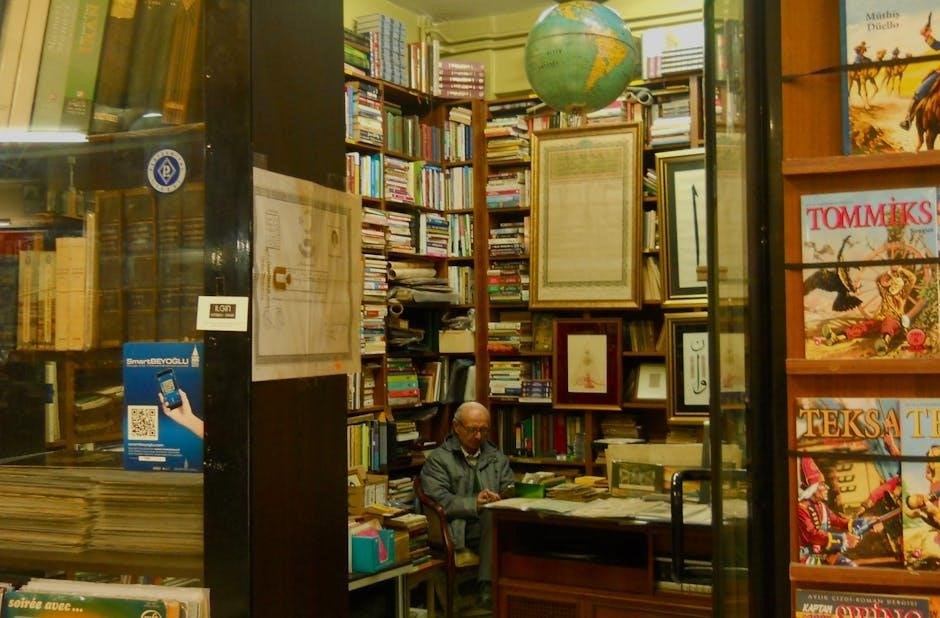The Culture Map by Erin Meyer: A Comprehensive Guide
The Culture Map‚ authored by Erin Meyer‚ serves as an essential guide for navigating global business. It offers insights into cultural differences‚ focusing on communication‚ feedback‚ and leadership. It’s research-based and relevant in our globalized world.
Erin Meyer’s The Culture Map is a pivotal resource for understanding cross-cultural dynamics in international business. It provides a framework to decode how people from different cultures think‚ lead‚ and operate. By analyzing varying cultural norms‚ Meyer offers practical strategies to mitigate misunderstandings and enhance global teamwork; The book addresses critical areas such as communication styles‚ leadership approaches‚ and decision-making processes across different cultures; It aids in improving cross-cultural communication and collaboration‚ making it essential for navigating the complexities of global business interactions and fostering cultural intelligence.
Understanding the Core Concepts
The core of The Culture Map lies in its eight-scale model. This model helps analyze cultural differences. It improves effectiveness for culturally diverse teams‚ and aids in correctly decoding the meaning of behaviors.
The Eight Scales of Cultural Differences
Erin Meyer’s framework highlights eight key areas where cultural norms diverge. These scales include communication styles‚ methods of evaluation‚ and persuasion techniques. Also included are leadership preferences‚ decision-making processes‚ trust-building approaches‚ and disagreement management. Finally it includes scheduling and time perception variations. Understanding a country’s placement on these scales helps individuals and teams navigate cross-cultural interactions more effectively. Recognizing these differences promotes smoother collaboration and minimizes misunderstandings in international business settings. This framework offers practical guidance for adapting strategies to diverse cultural contexts‚ fostering stronger global partnerships.
Communication Styles Across Cultures
Cultural communication varies significantly‚ impacting understanding and collaboration. Erin Meyer’s work explores direct versus indirect styles‚ highlighting potential misunderstandings. Awareness of these differences is crucial for effective cross-cultural interactions.
Direct vs. Indirect Communication
Erin Meyer’s “The Culture Map” highlights the spectrum between direct and indirect communication across cultures. Some cultures‚ like Germany and the Netherlands‚ value explicit and straightforward communication‚ while others‚ such as Japan and Korea‚ prioritize subtlety and reading between the lines. Misunderstandings can arise when direct communicators perceive indirect communicators as evasive‚ and vice versa. Navigating this scale involves understanding the cultural norms of clarity and nuance. Effective cross-cultural communication requires adapting your style to bridge this gap and avoid unintended offense or confusion. Recognizing these differences is key to successful global interactions.

Evaluation: Giving and Receiving Feedback
The Culture Map explores how cultures differ in giving feedback. Some favor direct criticism‚ others indirect. Understanding these nuances is vital for avoiding offense and fostering productive international relationships in professional settings.
The Spectrum of Feedback Styles
Erin Meyer’s Culture Map highlights a spectrum in feedback styles across cultures. Some cultures embrace direct‚ explicit negative feedback‚ viewing it as honest and helpful. Others favor indirect‚ subtle criticism‚ prioritizing politeness and saving face. This scale reveals how cultural norms shape perceptions of effective evaluation. Navigating this spectrum is crucial for international managers. Understanding where a culture falls helps tailor feedback appropriately. Direct feedback in indirect cultures can be demotivating. Indirect feedback in direct cultures may seem unclear. The book provides strategies for adapting your approach to maximize understanding and minimize offense‚ fostering better communication.

Leadership Approaches Globally
Leadership styles vary significantly across cultures‚ as detailed in “The Culture Map.” Understanding these differences is crucial for global leaders. The book explores diverse approaches to leading teams effectively‚ irrespective of cultural backgrounds.
Egalitarian vs. Hierarchical Leadership
“The Culture Map” explores leadership styles‚ contrasting egalitarian and hierarchical approaches. Egalitarian cultures value flat structures‚ where leaders are seen as facilitators. Hierarchical cultures favor clear chains of command‚ with leaders holding significant authority. Navigating this scale is critical for international management. Understanding where cultures fall on this spectrum helps avoid misunderstandings. Meyer’s research provides actionable insights for adapting leadership strategies. Recognizing these differences allows for more effective collaboration and team management across diverse global teams‚ thus improving overall project success rates. This knowledge is key to fostering respect and trust within multicultural environments.
Decision-Making Processes Worldwide
The Culture Map analyzes how decisions are made across cultures. Understanding these differences is crucial for global collaboration. The book provides insights into navigating diverse approaches‚ improving international teamwork and minimizing potential misunderstandings.
Consensual vs. Top-Down Decision Making
Meyer’s Culture Map explores the spectrum of decision-making‚ from consensual to top-down approaches. Some cultures prioritize collective agreement‚ fostering engagement. Others favor hierarchical structures where leaders decide swiftly. Understanding these cultural nuances is crucial for effective global collaboration. Recognizing where cultures fall on this scale is vital for navigating international projects. Leaders can adapt strategies to align with local norms. This will promote smoother interactions and improve decision-making efficiency across diverse teams‚ which helps minimize cultural misunderstandings. The insights are applicable in multiple global business settings.

Trust Building in International Contexts
The Culture Map highlights building trust‚ either through relationships or tasks‚ in international contexts. Understanding these approaches is vital for fostering collaboration and avoiding misunderstandings across diverse global teams;
Relationship-Based vs. Task-Based Trust
Erin Meyer’s The Culture Map explores differing approaches to trust. Some cultures prioritize relationship-based trust‚ emphasizing personal connections and rapport before business. Others favor task-based trust‚ where reliability and competence in delivering results are paramount. Successfully navigating global interactions requires understanding where cultures fall on this spectrum. Building rapport early might be crucial in some contexts. Demonstrating consistent‚ high-quality work may be more effective in others. Recognizing these nuances enables stronger‚ more productive international collaborations‚ minimizing misunderstandings and fostering mutual respect.
Navigating Disagreement Cross-Culturally
Cross-cultural disagreement resolution varies widely. The Culture Map illuminates these differences‚ offering strategies to navigate conflict constructively. Understanding cultural norms around confrontation is key for effective communication and resolution in international settings.
Confrontational vs. Avoidant Disagreement Styles
Some cultures embrace direct‚ open disagreement‚ viewing it as a path to resolution. Others prioritize harmony‚ avoiding direct confrontation to maintain relationships. The Culture Map highlights this spectrum‚ explaining how cultural norms shape approaches to conflict. Understanding where a culture falls on this scale is crucial for effective cross-cultural communication. Misinterpreting disagreement styles can lead to misunderstandings and damaged relationships. By recognizing these differences‚ individuals can adapt their communication strategies to foster constructive dialogue and find common ground‚ ultimately leading to more successful international collaborations and partnerships‚ which the book aims to help the reader with.

Scheduling and Time Perception
The Culture Map explores how cultures perceive time differently. Some favor linear‚ structured schedules‚ while others embrace flexibility. Understanding these variations helps avoid misunderstandings and improve collaboration across cultures‚ as highlighted in Meyer’s book.
Linear-Time vs. Flexible-Time Cultures
Meyer’s Culture Map highlights contrasting approaches to time. Linear-time cultures prioritize schedules‚ punctuality‚ and sequential task completion. Deadlines are firm commitments. Flexible-time cultures view schedules as guidelines‚ emphasizing adaptability and relationships over strict adherence. Delays are common‚ and interruptions are expected. This difference impacts project management‚ meeting protocols‚ and overall work styles. Understanding these contrasting perceptions‚ outlined in The Culture Map‚ is vital for effective cross-cultural collaboration‚ minimizing frustrations‚ and fostering mutual respect in global business interactions. Recognizing these time-related cultural nuances facilitates smoother workflows and stronger international partnerships.
Practical Applications in Global Business
The Culture Map offers practical tools for improving communication‚ leadership‚ and teamwork across cultures. Applying its insights enhances collaboration‚ minimizes misunderstandings‚ and fosters stronger international business relationships. It is essential reading.
Improving Cross-Cultural Communication and Collaboration
To enhance cross-cultural communication‚ The Culture Map emphasizes understanding diverse communication styles‚ including direct and indirect approaches. Adapt your communication to suit the cultural context. Actively listen and clarify misunderstandings. Build trust by respecting cultural norms and values. Promote inclusive teamwork by valuing diverse perspectives. Facilitate open dialogue to address conflicts constructively. Foster cultural intelligence through continuous learning. Encourage empathy to bridge cultural gaps. Tailor leadership styles to motivate diverse teams effectively. This approach boosts collaboration and shared success.
Criticisms and Limitations of the Model
Potential overgeneralization and cultural fluidity present limitations. Critics question methodologies and Western biases. Rapid cultural changes can quickly make observations outdated. Applicability to subcultures and multicultural individuals can vary greatly.
Addressing Potential Overgeneralizations and Cultural Fluidity
While The Culture Map provides a valuable framework‚ it’s crucial to avoid rigid application of the cultural scales. Cultures are dynamic and individuals within them can vary significantly. The model’s broad strokes might not capture the nuances of subcultures or multicultural identities. Globalization and rapid societal shifts can lead to quick changes‚ rendering some observations outdated. Continuous learning and adaptation are essential‚ acknowledging that cultural understanding is an ongoing process. The book’s insights need to be applied with flexibility‚ recognizing the complexities of intercultural interactions and the importance of individual perspectives over generalizations.
The Culture Map encourages continuous learning and adaptation. Cultural intelligence becomes vital in a globalized world. Understanding and appreciating diverse interaction styles enhances success in international business and fosters deeper human connections.
The Importance of Continuous Learning and Adaptation
In today’s rapidly evolving global landscape‚ continuous learning and adaptation are paramount. The Culture Map emphasizes that cultural understanding is not a static achievement‚ but an ongoing process. As societies change and global interactions increase‚ individuals must remain open to new perspectives and adapt their approaches accordingly. Embracing cultural fluidity allows for more effective cross-cultural communication‚ collaboration‚ and overall success in diverse environments. This commitment to continuous learning fosters stronger relationships and minimizes misunderstandings in an interconnected world‚ making adaptability a crucial skill for navigating global complexities.